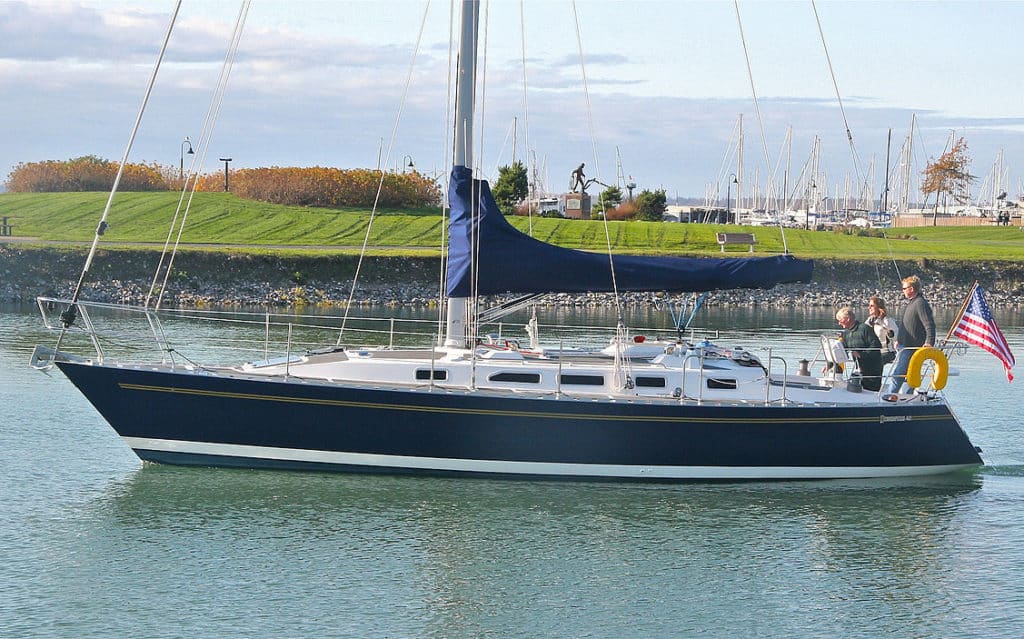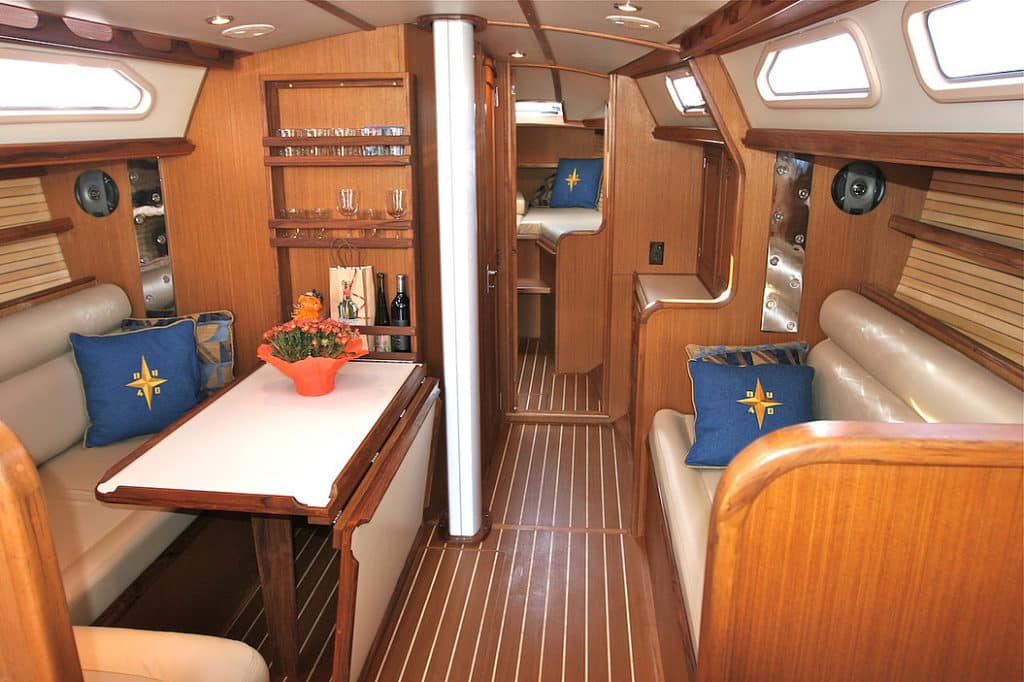
The Norstar 40 might just as well have been named the Phoenix 40 because, after an 18-year hiatus, this Robert H. Perry design has risen from the ashes of financial ruin and been given a new lease on life.
The Nordic 40 was a popular cruising design known for its stylish looks, peppy performance, and robust construction. Between 1978 and 1991, 32 Nordic 40s and 39 of the very similar Nordic 44s were built, and to this day they boast a loyal following of owners.
It isn’t surprising that such a pedigree design would stand the test of time. What didn’t stand the test of time was Nordic Yachts, for it, like many American boatbuilding concerns, fell victim to the 1990 luxury tax imposed on the industry.
Steve Nordvedt, the founder of Nordic Yachts, remembers those convulsive times well. “Within nine months of that tax legislation” he says, “we were forced to auction off all of our tooling and close our doors.”
But Steve and his brother, Gary, come from a family of boatbuilding. They are sons of Art Nordvedt, who founded Uniflite in Bellingham, Washington, and designed and built powerboats there for many years. So, with a lifetime in the boatbuilding industry themselves, they couldn’t help but jump back into the fray.
In 1994, Gary established Norstar Yachts in Bellingham and began producing a line of powerboats ranging from 30 to 36 feet. With Gary as president and builder, and later the addition of Steve as director of business development, Norstar has thrived. But when the price of diesel fuel recently approached the symbolic US$5 per gallon mark, they decided it was time to get back into the sailboat genre.
They could’ve gone with an entirely new design, but on reflection, they felt that the old range of Nordics stood their ground well against even the most modern of yachts.
When they first located their old molds, they almost despaired because from the outside, they looked the worse for wear. But fortunately, they’d been stored in such a way as to keep the all-important interior surfaces free of ultraviolet degradation and other damage. They purchased the molds, and the exclusive rights to build the boats, from their then owner.
They didn’t trot out the Norstar 40 like mutton dressed as lamb. They proudly advertised that the Nordic 40 was back with barely more than a change in name. In fact, the only physical alteration is a new drop-down transom designed by Gary that allows ease of access aft.
The hull is made of solid glass. After the ISO/NPG gelcoat is sprayed into the molds, an epoxy barrier coat of Interlux 2000E is applied, followed by two layers of mat with vinylester resin. Gary then switches to hand-laid woven mat and roving layers with polyester resin.
The balsa-cored deck is fastened to the hull’s 3.5-inch inward-turning flange with 5200 adhesive, then through-bolted on 4.25-inch centers.
An enormous T-shaped cockpit with high seatbacks and wide coamings offers comfortable seating separated from the 36-inch destroyer wheel and helm station. Both mainsheet and the jib sheet are handy to the helm, and all halyards, the traveller, and reefing lines are centralized on the cabin top. A semi-hard dodger provides ample protection and well-placed handholds.
The bridgedeck is a commendable 20 inches high, preventing any chance of downflooding. The Goïot companionway hatch is simply the best that I’ve ever seen in terms of strength, watertightness, and access to the latches from above or below.
Polygrip, a dimpled rubber matting, is recessed into the decks to make an effective and attractive nonskid system. Stout stern and bow pulpits, 28-inch-tall coated lifelines, and numerous handholds assure safe movement on deck.
The foredeck has efficient working spaces, and the recessed windlass, rollers, chalks and cleats are well designed and installed. My only criticism regards the lack of access to the chain locker.
A 50-pound-capacity propane locker, 120 gallons of fresh water, and a 54-gallon fuel tank attest to the long-legged nature of this cruiser.
The Ballinger spars sport a fully battened main and a Harken furled headsail. The fairlead tracks are placed well inboard, tightening the sheeting angles. A sail area-to-displacement ratio of 17.61 places the Norstar in the cruiser/racer category, but that number alone doesn’t tell the whole story.
A 6-foot-6-inch fin keel with over 7,000 pounds of lead concentrated in its forefoot makes this one stiff boat and protects the hull in the event of a grounding. Fine entry and efficient exit lines aft make this one slippery sailer. However, the full skeg and rudder create sufficient lateral resistance aft to eliminate any skittish behavior.
In just 10 knots of breeze, we had the Norstar 40 sailing happily at 6.75 knots on the beam and 7 knots when closehauled. The boat tracked well, tacked quickly, and generally showed superb manners while under way.
With the 55-horsepower Yanmar diesel and a three-bladed Max-Prop, we motored at a brisk 6.5 at a cruising rpm of 2,400. Good access is provided to the engine, and I found it and all other systems installations to be of professional quality.
Norstar offers either a Traditional or a Special Edition interior with two different finishes possible. The “Herreshoff” is whitewall and wood; the other is teak. I viewed the traditional teak layout and found it to be of fine fit and finish.

The large galley has spacious counter space, a large fridge/freezer, a three-burner stainless-steel stove, and twin sinks. A drop-down saloon table uncovers an elegant wine and glass locker. A usable navigation station, one roomy head/shower, a double pilot berth aft, and a comfortable V-berth forward are other highlights of this simple yet efficient living space. Four dorades and six opening hatches provide breezy ventilation.
Overall, I concur with the Nordvedt brothers. The boat that Bob Perry drew way back in the 1970s was a very good design then and is a very good design now. If one is looking for a still stylish, sprightly, and fully capable ocean cruiser, they needn’t look much farther than Bellingham, Washington.
Alvah Simon is a CW contributing editor and veteran Boat of the Year judge.
Specs
LOA 39′ 8″ (12.09 m.)
LWL 32′ 6″ (9.91 m.)
Beam 12′ 5″ (3.78 m.)
Draft 6′ 6″ (1.98 m.)
Sail Area (100%) 756 sq. ft. (70.2 sq. m.)
Ballast 7,091 lb. (3,216 kg.)
Displacement 18,000 lb. (8,165 kg.)
Ballast/D .39
D/L 234
SA/D 17.6
Water 120 gal. (454 l.)
Fuel 54 gal. (204 l.)
Holding 44 gal. (167 l.)
Mast Height 57′ 4″ (17.48 m.)
Engine 55-hp. Yanmar
Designer Robert H. Perry
Sailaway Price $425,000
Norstar Yachts
(360) 223-2399
www.norstaryachts.com








